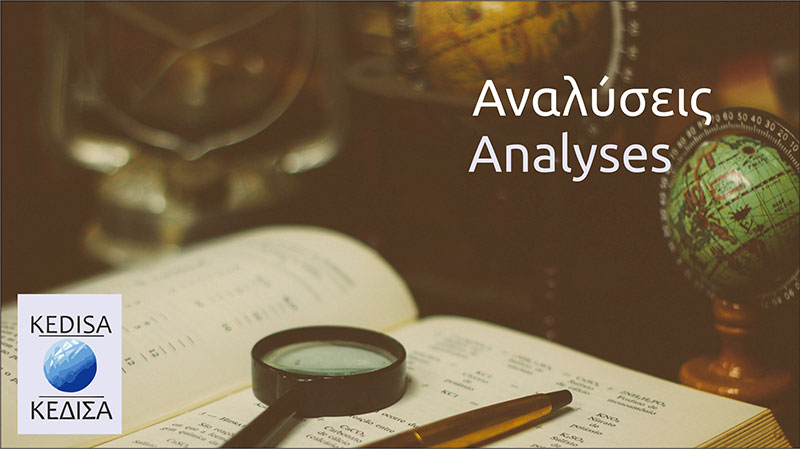By Georgia Kiosi, Analyst KEDISA
Iran’s nuclear program has for long been a subject of debate on the global stage, sparking concerns over its potential to develop nuclear weapons and its ramifications for regional and international security. As Iran currently navigates complex diplomatic, economic, and security challenges, its nuclear strategy is a critical factor in shaping the Middle East’s geopolitical landscape.
In 2015, Iran signed the Joint Comprehensive Plan of Action (JCPOA), popularly known as the Iran Nuclear Deal, agreeing to suspend its nuclear ambitions in exchange for relief from Western- imposed sanctions.[1] However, in 2018, the United States withdrew from the agreement, under President Donald Trump, citing concerns over Iran’s ballistic missile program and regional activities. Iran then resumed and expanded its nuclear operations and increased its uranium enrichment from 3.67% to 20%.[2]
It is estimated that from 2019 to late 2023, Iran accumulated approximately 4,486.8 kg of enriched uranium.[3] In 2020, in response to the assassination of nuclear scientist Mohsen Fakhrizadeh by the Israeli government, Iran increased its uranium enrichment to over 60% purity.[4] Remarkably, in February 2024, Ali Akbar Salehi, who served as Iran’s Foreign Minister from 2010 to 2013 and as the former head of the Atomic Energy Organization stated that “ (Iran possesses) all the thresholds of nuclear science and technology.”[5]
Since 1989, Ali Hosseini Khamenei has served the Islamic Republic of Iran as its Supreme Leader, exerting significant influence over Iran’s nuclear program. While he permitted the JCPOA negotiations to proceed under the leadership of President Hassan Rouhani, he has consistently demonstrated a preference for maintaining Iran’s nuclear capabilities. Moreover, Khamenei’s deep mistrust of the International Atomic Energy Agency (IAEA) has further hindered the agency’s ability to effectively monitor Iran’s nuclear activities.[6]
Evidently, the collapse of the JCPOA prompted Iran to advance its nuclear programs, becoming a latent nuclear state, namely a state capable of rapidly developing a nuclear arsenal if faced with a significant security threat.[7] As Kamal Kharrazi, a senior advisor to Khamenei and head of Iran’s Strategic Council on Foreign Relations (SCFR) declared, “(Iran has) no intention of producing a nuclear bomb, but if (its) existence is threatened, we will be forced to change our nuclear doctrine.”[8]
According to IAEA, Iran possesses the capacity to produce enough uranium to arm several nuclear weapons within weeks.[9] The IAEA defines the threshold for creating an atomic bomb as approximately 42 kg of uranium enriched up to a purity of 60%. Based on the latest IAEA report, Iran has accumulated 121 kg of uranium enriched to this level, which is enough to produce nearly three nuclear bombs.[10] Notably, Iran is the only country enriching uranium at this extent without a confirmed nuclear weapons program. Interestingly, the fact that Iran has the ability to swiftly create nuclear weapons but without actually producing them, allows it to technically remain compliant with the Nuclear Non-Proliferation Treaty (NPT), this policy known as the “Japan Option”.[11]
The economic pressures and ongoing Western sanctions against Iran cannot be overlooked. It is apparent that the persistent external pressure to contain Iran and dismantle its political system has left Tehran with no option but to evolve into a paranuclear state, Iran’s missile capabilities serve as a clear show of force.
Recent incidents suggest that Tehran has shifted away from its policy of strategic patience and is no longer willing to fight a shadow war. Iran’s January 16th, 2024, missile strike on Pakistan, a response to a Jaish al-Adl terrorist attack on the port city of Chabahar, along with its April 13th, 2024, launch of over 300 drones and ballistic missiles against Israel after an Israeli airstrike on its consulate in Damascus, marking its first ever direct attack on the country, and its subsequent attack on October 1st, 2024, with a barrage of over 200 ballistic missile strikes, reflect a change in Iran’s stance.[12] In light of that, General Ahmad Haqtalab, an Islamic Revolutionary Guard Corps (IRGC) commander responsible for the security of Iran’s nuclear installations, made clear that Israel’s rising threats against Iran risk “a reconsideration of the Islamic Republic of Iran’s nuclear doctrine and policies, and a departure from previous declared considerations.”[13]
For the Iranian authorities, possessing nuclear capabilities serves not only as a deterrent against large-scale military attacks but also as a diplomatic leverage in negotiations with the United States and other adversaries. By maintaining, strategic ambiguity around its nuclear capabilities, Iran can leverage this stance as a tool for political negotiations.
Iran’s shifting approach, from strategic patience to direct military confrontations, highlights its growing determination to assert itself in regional and global affairs. With its continued nuclear advancements, missile capabilities, and evolving stance in strategy, Iran is positioning itself as a key player in the geopolitics of the Middle East.
Sources
Azizi, Hamidreza. “Iran’s Shifting Discourse on Nuclear Weaponization: Bargaining Tactic or Doctrine Change?”, Middle East Council on Global Affairs, 2024.
Shokri, Umud. “Iran’s Nuclear Ambitions: U.S. and EU Strategies for the New President”, Geopolitics, Gulf international Forum, 2024.
Yazdanshenas, Zakiyeh and Saleh, Alam. “Iran’s new nuclear policy between deterrence and pragmatism”, Middle East Institute, 2024.
Yazdanshenas, Zakiyeh and Saleh, Alam. “Iran’s nuclear messaging campaign”, Middle East Institute, 2024.
Endnotes
[1] Yazdanshenas, Zakiyeh and Saleh, Alam. “Iran’s nuclear messaging campaign”, Middle East Institute, 2024.
[2] Yazdanshenas, Zakiyeh and Saleh, Alam. “Iran’s nuclear messaging campaign”, Middle East Institute, 2024.
[3] Shokri, Umud. “Iran’s Nuclear Ambitions: U.S. and EU Strategies for the New President”, Geopolitics, Gulf international Forum, 2024.
[4] Yazdanshenas, Zakiyeh and Saleh, Alam. “Iran’s nuclear messaging campaign”, Middle East Institute, 2024.
[5] Azizi, Hamidreza. “Iran’s Shifting Discourse on Nuclear Weaponization: Bargaining Tactic or Doctrine Change?”, Middle East Council on Global Affairs, 2024.
[6] Shokri, Umud. “Iran’s Nuclear Ambitions: U.S. and EU Strategies for the New President”, Geopolitics, Gulf international Forum, 2024.
[7] Yazdanshenas, Zakiyeh and Saleh, Alam. “Iran’s nuclear messaging campaign”, Middle East Institute, 2024.
[8] Azizi, Hamidreza. “Iran’s Shifting Discourse on Nuclear Weaponization: Bargaining Tactic or Doctrine Change?”, Middle East Council on Global Affairs, 2024.
[9] Yazdanshenas, Zakiyeh and Saleh, Alam. “Iran’s nuclear messaging campaign”, Middle East Institute, 2024.
[10] Yazdanshenas, Zakiyeh and Saleh, Alam. “Iran’s new nuclear policy between deterrence and pragmatism”, Middle East Institute, 2024.
[11] Yazdanshenas, Zakiyeh and Saleh, Alam. “Iran’s nuclear messaging campaign”, Middle East Institute, 2024.
[12] Yazdanshenas, Zakiyeh and Saleh, Alam. “Iran’s new nuclear policy between deterrence and pragmatism”, Middle East Institute, 2024.
[13] Azizi, Hamidreza. “Iran’s Shifting Discourse on Nuclear Weaponization: Bargaining Tactic or Doctrine Change?”, Middle East Council on Global Affairs, 2024.
 English
English

